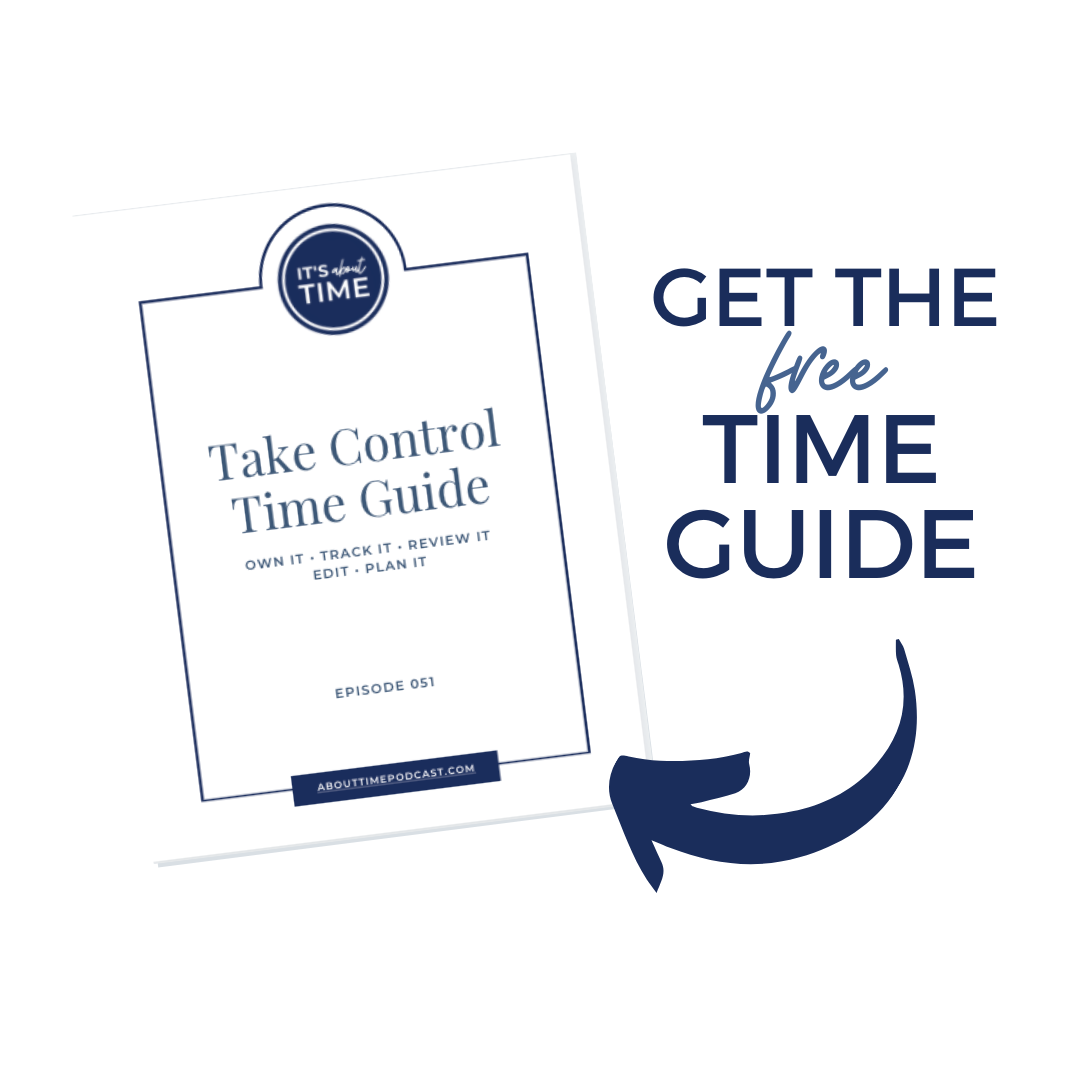LISTEN IN APPLE PODCASTS | LISTEN IN SPOTIFY | LISTEN IN STITCHER

How do I adjust when my time isn’t my own?
How can I manage my time well when so much of what I do isn’t up to me?
When my days are full of doing things for other people, how can I make any time for myself?
Episode 51 was inspired by a member of the It’s About Time podcast community who asked about how to manage your time when your time is not your own.
Her question really got my wheels turning about how taking care of children, and being a caregiver to aging or sick parents or other family members can require a big investment of our time. Not only that – work, whether you’re logging in as a 9-5 professional, clocking into your shift, or running your own business – sometimes there’s a lot about our working lives we feel we just can’t control.
It makes time management feel almost pointless.
Truthfully – I’ve been there. In my crisis communication days, I all too often felt that my time was not my own – constantly on call, missing family events and baby showers to do emergency client work – and I felt hopeless, and helpless to do anything about it. After all – that was my job. What could I do?
Well… Live and learn – and then talk to you about it in a podcast episode.
I’m here to give you some hope, even if you feel like you’re stuck in a hamster wheel that someone else is spinning while you desperately try to keep up.
I’ll walk you through five simple steps you can take to sort through the overwhelm and start carving out time with intention.We’ll start with why you actually have more control over your time than you might think.
Sound good?
Ok – here we go. On the road to managing your time well when you believe your time is not your own, there are five stops along the way to, dare I say it – feeling more free.
First, we’re going to Own it.
Then, we’re going to Track it.
Once we Track it, we’re going to Review it.
Then, we’ll Edit.
And finally, we’ll plan it.
Own it. Track it. Review it. Edit it. Plan it.
01. Own it
Let’s start with Step 1 – Own it.
Step 1 is less about moving things around on your calendar, and more about shifting your thoughts about time, ownership and responsibility.
Repeat after me. I am in control of how I spent my time.
One more time. I am in control of how I spend my time.
Understanding and believing that you, and only you, are in control of how you spend your time is an absolute necessity and game changer in your life.
Now – I’ll admit, there was a time that I didn’t believe those words myself. My calendar was once jam packed, and filled to the brim with meetings, activities and work that reflected other people’s priorities.
Frankly, I was miserable. My days started rushed, and I always woke up feeling behind and also exhausted from working late the night before. Once I made it to the office, usually late, I raced around from meeting to meeting about things I wasn’t passionate about, squeezing in haphazard desk work and failed attempts to focus in between. Usually anything that required true focus and concentration was pushed until after I got home because I hadn’t figured out a way to do Deep Work in an open office setting, therefore continuing the cycle of staying up late trying to catch up. I honestly can’t imagine what it would have been like to live that frantic and unfulfilling lifestyle while raising kids.
Someone very close to me told me when I was in that unhappy season of life,
“You’re not supposed to like your job. You’re just supposed to show up, do the work, go home and enjoy your life on the weekends.”
I think she was trying to make me feel better, but instead, her words made me feel sick.
Have you ever been told that? Or been given similar advice? That working for the weekends is all there is to life? What do you believe?
I knew there had to be a better way, but I didn’t know what it was or how to get there.
This cycle of spending my days unhappy and my evenings and weekends working continued for a while, years even – until I decided I’d had enough. This realization certainly didn’t take place overnight… but it was the result of gradually being exposed to more and more examples of people – of women specifically, who had designed lives and careers that set their souls on fire. Lives and careers that didn’t fit the narrative I was sold.
Lives they loved, careers that were fulfilling – all while having fun, spending time with family and doing work with purpose. They were cultivating what matters, living the simplified life and working from a place of rest, not hustle.
If they could create that, why not me?
And If they create that, why not you?
Friend – it starts with owning it. Owning that you are, in fact, in control of your time.
You always have a choice. If you don’t like your job, you actually can leave. No one is forcing you to go each day. If you own a business and your clients or client work is taking over your life – you’re the boss. You get to decide how and when you serve. And if you’ve got little ones or you’re taking care of aging or sick parents, there is still choice built into the equation.
The problem is – and what often leads to a feeling of being stuck or that we don’t have control of a situation is our options, our alternatives. Typically, when we believe the lie that we don’t have a choice in the matter, it’s because the alternatives are unappealing. They’re hard. They take a lot of time or effort.
I had a similar conversation with one of my time management coaching clients recently who wants to replace two critical team members who are performing poorly. The problem is – the process of finding, hiring and training someone new to take over those responsibilities feels SO much more daunting – even though it would probably be the better choice in the long run. But – he knows he has a choice, even if the choice isn’t an easy one to make.
You might hate your job, and feel that you have no choice but to stay. You have bills to pay and a family to take care of.
But really – what are your other options? Could you search for a new job? Could you cut your expenses, begin saving more and create a financial buffer that would allow you to start the business you’ve been dreaming of? Could you prepare for and have a conversation with your boss – proposing a raise, a promotion, a part-time or remote arrangement, or a shift in responsibilities? What are your options? You always have options. And if the options aren’t good, then you’re not “stuck” you’re choosing to stay. You’re in control.
Or maybe you’re running your own business, but your clients are taking over your life.
Calling you at all hours of the day, reaching out on weekends.

Photo Credit: Sarah Becker Photography
You feel like you can’t dig out of the mountain of work on your plate.
You started your business for more freedom, but somehow you have even less.
What are your options?
Could you create more boundaries around client relationships, establishing clear policies for communication?
Could you set office hours and stick to them?
Could you redistribute your budget and hire part time help or a freelancer to assist with project work?
What are your options?
Again – you always have options. And if you do nothing, it’s not because you’re stuck, it’s because you’re choosing to keep things the same.
Last example with taking care of children or being in a caregiver role – there are always options.
Here’s an example I gave someone recently from my own life.
Maybe this will surprise you – but I only work around 20 to 25 hours a week in my coaching business and on the podcast.. If I skip all of my workouts, wake up at 5AM to start working – which I do on occasion. It’s actually 5:22 am as I’m writing this – and add in a few post-bedtime hours working late, I can get closer to 30 or 35.
Sometimes I catch myself thinking – I’d like to work more, but I don’t have a choice.
And of course I know that’s wrong. My 20-25 hours are a result of my daughter’s child care schedule. 99% of the time, I do morning routine, drop off and pick-up because my husband’s work schedule is very unpredictable. So that means that my work happens while she’s at school.

Photo Credit: Sarah Becker Photography
If I really wanted to work more, I have options.
I could hire someone, like a mother’s helper, to pick her up from school and watch her while I finish up for the day. We could hire an au pair and have live-in help. But – that would also mean less time with her, and it would be an additional expense that we could make if we shifted our budget around, but both options are unappealing. So – I choose to do drop off and pickup and work the hours in between.
Another one of my time management coaching clients was stressed because she felt she didn’t have enough time to work on her grow side business. She’s working full time and spends 5-6 hours a week in the evenings with her daughter at gymnastics and dance lessons. Our solution? Instead of spending that idle time phone scrolling, decide in advance what you’ll take with you to work on while you’re there. If you’re spending hours a week in a hospital waiting room while a loved one has treatments or appointments – how can you use that time to your advantage, instead of falling into default mode.
Either way – please know that even though sometimes you have to get creative, and even though the options aren’t always appealing – you have a choice and you are in control of how you spend your time. I’d rather you feel empowered in your choice than a victim of your circumstances. It’s all in your perspective. Own it.
Once you own that you’re in control, it’s time to see where your time is actually going.
02. Track It
We’re going to track it.
If you keep your appointments in a calendar like a paper planner or in Google calendar, take a look at your past few weeks. If you use time blocking and task batching during your weeks and you add those blocks to your calendar in addition to your meetings and appointments, then you’re ahead of the game.
Now, I challenge you to spend a week writing down everything you do – tracking your time, doing a Time Study.
Doing a Time Study is usually one of the first steps that my coaching clients take to bring more awareness to how they’re actually spending their time. When we move from one thing to the other in our day to day lives, a lot gets lost on us – and we don’t necessarily realize how much time we’re wasting – and sometimes we don’t realize how productive we really are!
Doing a time study also uncovers useful pockets of time, and gives us the insight we need to rearrange in order to design a more fulfilling life.
The first step to doing a time study:
Decide where you’ll track your time. Here are three places you can do that.

Photo Credit: Geauxgarcia Photography
-
Keep a note in your phone of how you’re spending your time in 15 to 30 minute increments.
-
Use a spreadsheet to capture how you’re spending your time in the cells.
-
Or capture in your calendar how you’re spending your time beyond just your meetings and appointments. If you have enough space to write in your paper planner go with that, and if you use something like Google Calendar just create appointments to represent that time.
As you’re tracking your time, I encourage you to get as granular and specific as you can. Phone call with Sarah about the TPS report is much more insightful than just Phone call. Include your commute time, your shower time, and yes – even your mindless Instagram and facebook scrolling time. And if you do several different things within a 15 minute time frame, which thing did you spend the most time doing?
Once you’ve done your time study, it’s time to move from Track it to Review it.
03. Review It
Scan your time study – whether it’s in your phone notes, a spreadsheet or your calendar and see what categories emerge. If you want to get crazy, add up how much time you spend on each category. One of my clients was shocked to find that she spent 9 hours consuming social media content, because 15 minutes here and there add up. And that didn’t even include the time she spent creating and posting content.
As you’re reviewing your completed time study, ask yourself the following questions:
-
When was I the happiest during my week?
-
When was I most stressed or frustrated?
-
When was I most productive?
-
When did I typically waste time?
-
When did I feel really great?
-
When did I feel exhausted?
-
And then – What is my biggest takeaway from this experience?
After you track it, as you review it – asking these questions is when the a-ha moments arrive. This is when you begin to see a realistic picture of how you’re actually spending your time.
04. Edit
After you review it – it’s time to edit. Break out the red pen and let’s see what we can do.
Now that you’ve identified when you feel great, when you feel not-so-great, which parts of the day stress you out, and when you’re most productive – you’re equipped to edit. This is when we start to move things around.
What can you change or adjust about how you’re spending your time to serve you better? What can you quit doing altogether that isn’t serving you. Last week I shared in Episode 50 that I walked away from a nonprofit chair position because I realized that it was I allowing it (keyword allowing – everything is a choice, remember?) I realized I was allowing it to drain my time, my energy and my positivity. And if you’re afraid of quitting because someone told you when you were younger that quitters never win?
Quitters can absolutely win – especially when it means freeing up time to spend on something more fulfilling and meaningful. If you want to quit something, you have my full support. You don’t have to be a hero and stick it out if you’re miserable. Life is too short and we only get one.
What can you change, adjust, move around or quit in order to use your time in a way that’s fulfilling. How can you take advantage of those parts of the day when you’re feeling great to get important work done? How can you be ready for naptime hustle when your little ones lay down so you can use that time wisely on something you need or want to do? How can you use existing pockets of time that you usually fall into default mode in a more fulfilling or productive way.
Here’s the thing – every single minute of your day does not have to be the most productive minute ever. That’s why I often prefer fulfilling over the word productive.
It’s kind of like those SAT study questions – at least from what I’ve seen on TV and movies, I actually didn’t take the SAT, I took the ACT.
Like this – All squares are shapes, but not all shapes are squares.
All things that are fulfilling are productive, but not all things that are productive are fulfilling.
And of course this is just MY opinion.
For example, Lingering over coffee with your significant other before you head out the door might not be society’s definition of productive because you’re not crossing something off of a list, but in my world – it’s productive because it’s fulfilling. Intentionally nurturing a relationship fills your soul. Spending 15 minutes of one on one time with all attention on your kiddo might not be society’s definition of productive, but it’s definitely fulfilling.
So before we move on, I encourage you to ask yourself two questions:
First – What does fulfilling mean to you?
Second – What does productive mean to you?
And finally – now that we’ve Owned it, Tracked it, Reviewed it and Edited it – it’s time to plan it.
05. Plan It
Take what you’ve learned from reviewing it, and look at what you’ve edited. Now – create a plan for your week that puts YOU in the driver’s seat. You’re in control, you call the shots, and you make the rules.
Back in Episode 48, I shared my secret for getting everything done by designing an Ideal Week – a template for how I want to spend my time. If you haven’t listened to that one yet, head that way next.
You’ll want to design an ideal week for yourself, one that is both fulfilling and productive. And then at the start of each week – take a look at that ideal week and make adjustments based on reality. What stays, what goes and what gets moved around to accommodate real life?
If you truly want to take back your time, feel that you’re in control, and step into each week feeling calm and prepared – that’s the answer. Simple? Yes. Easy – most worthwhile things in life are not – that’s why it’s easier to live life in default mode – but I know you don’t want that – and I don’t want that for you either.
We can absolutely work with what we’ve got and it starts with owning that you, my friend, are in control.
LISTENER SPOTLIGHT

PamelaTea123 – Haha – Time-tested, that’s a good one, and I am so proud to call you a friend! That’s all I want – is for you to feel like you’re in charge and running your life, and I truly hope that through the solo episodes and guest interviews on It’s About Time that you’re finding ways to make life just a little better. I’m so thankful to have you as a listener, and thank you so much for taking the time to leave such a kind and thoughtful review. I really do have the best listeners! Y’all are just wonderful.
SUBSCRIBE & REVIEW IN ITUNES
If you’re enjoying It’s About Time so far, I hope you’ll take a moment to subscribe if you haven’t yet – I don’t want you to miss an episode! I’ve got a few bonus episodes in the works, and you might miss them if you’re not subscribed. Click here to subscribe on iTunes.
If really like what you hear, I’d be so grateful if you left me a review over on iTunes, too. Your review play a HUGE role in helping others find out about It’s About Time. And honestly, they’re really fun for me to read! Click here to review, select “Ratings and Reviews” and “Write a Review” and let me know what you’re loving about It’s About Time. Thank you!!
LINKS & RESOURCES MENTIONED IN THIS EPISODE
-
Join the It’s About Time Academy!




Be the first to comment